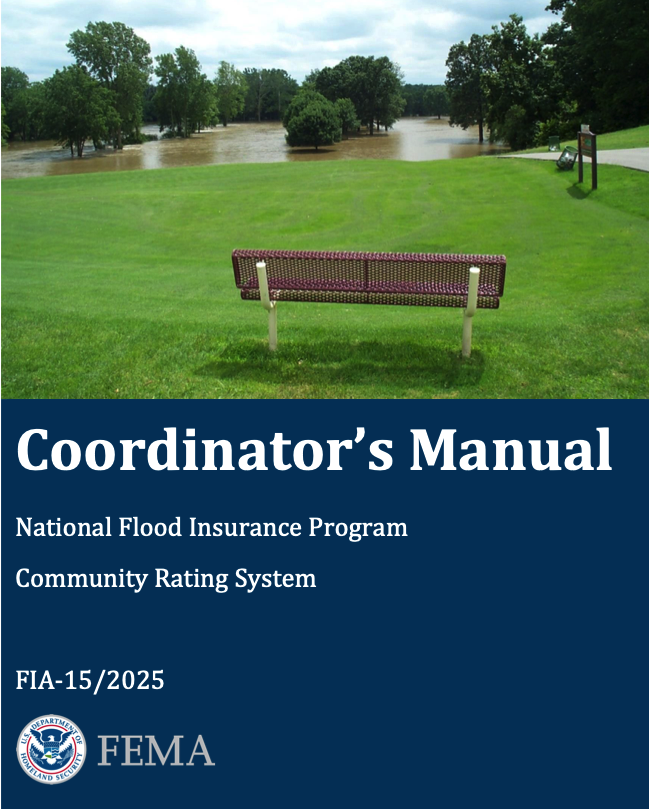 The objective of the Community Rating System (CRS) is to recognize communities that are doing more than meeting the minimum NFIP requirements to help their citizens prevent or reduce flood losses. The CRS also provides an incentive for communities to initiate new flood risk reduction activities. The Coordinator’s Manual is the guidebook for the Community Rating System and sets the criteria for CRS credit and classification. It explains how the program operates, what is credited, and how credits are calculated. Although it is primarily a reference for CRS activities and credits, it can also help guide communities that want to design or improve their floodplain management programs.
Download the 2025 Coordinator’s Manual
The objective of the Community Rating System (CRS) is to recognize communities that are doing more than meeting the minimum NFIP requirements to help their citizens prevent or reduce flood losses. The CRS also provides an incentive for communities to initiate new flood risk reduction activities. The Coordinator’s Manual is the guidebook for the Community Rating System and sets the criteria for CRS credit and classification. It explains how the program operates, what is credited, and how credits are calculated. Although it is primarily a reference for CRS activities and credits, it can also help guide communities that want to design or improve their floodplain management programs.
Download the 2025 Coordinator’s Manual
Helpful Resources
The following guides, checklists, and other materials, most of them referred to in the CRS Coordinator’s Manual, are optional aids to help communities with their CRS programs.
-
- Summary of changes in the 2025 Community Rating System Coordinator’s Manual (⬇Download .pdf)
- Master List of Elements – 2021 Addendum to the Coordinator’s Manual (⬇Download .pdf)
- Accessing NFIP Repetitive & Severe Repetitive Loss Data (Pending Update)
- 2021 Class 8 Freeboard Prerequisite: Frequently Asked Questions (⬇Download .pdf)
- Impact Adjustment Maps—An overview and step-by-step guide to producing a map to help analyze and pinpoint the impact of floodplain management techniques. (⬇Download .pdf)
- CRS Credit for Habitat Protection—An overview and guide to the ways communities can protect natural habitat while earning CRS credit. (⬇Download .pdf)
- CRS Fact Sheets
- Community Rating System Overview and Participation (⬇Download .pdf)
- Small Communities in the CRS—A six-page fact sheet to help small communities gauge, step-by-step, their ability to participate in the CRS, along with explanation of program benefits. (⬇Download .pdf)
- Considerations for Community CRS Coordinators after a Major Flood—Helps community CRS coordinators as they assess their workload after a disaster. (⬇Download .pdf)
- CRS Credit for a High Water Mark Initiative—Describes how signs showing the high point of past flood waters helps raise public awareness and earn CRS credit. (⬇Download .pdf)
- Tsunami Preparedness & the Community Rating System—Points out the ways communities can better manage their tsunami hazard and receive CRS credit points for their efforts. (⬇Download .pdf)
- Tsunami Outreach & the Community Rating System—Describes how communities can improve awareness of the tsunami risk while also earning CRS credit. (⬇Download .pdf)
